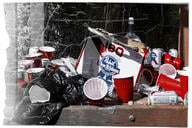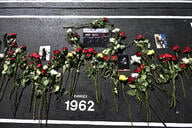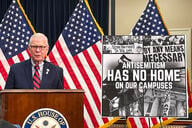You have /5 articles left.
Sign up for a free account or log in.
A crowd of about 1,500 people -- many of whom were college students -- gathered on the University of California’s Berkeley campus this month to peacefully protest the appearance of conservative writer and provocateur Milo Yiannopoulos.
They had come to march, to carry signs and to raise their voices in dissent of the Breitbart figure’s controversial points of view, as is within their First Amendment rights. They did not come to start fires or break windows.
But their message was overshadowed by another, smaller mass of about 150 protesters who did come to start fires, break windows and hurl rocks at police officers -- and who accomplished all of those things. They wore black and concealed their faces with masks. They brought -- and used -- bats, metal rods, fireworks and Molotov cocktails to get their message across, in the process undermining “the First Amendment rights of the speaker as well as those who came to lawfully assemble and protest his presence,” a spokesperson for Berkeley said in a statement.
The group, which many have characterized as one made up of anarchists, was practicing black bloc tactics.
Black bloc is a strategy intended to unify protesters through their black clothing, masks and paramilitary tactics. The protesters become indistinguishable from one another, creating confusion for law enforcement officials and chaos among innocent bystanders.
Black bloc is more of a shifting movement and shared strategy than a formal organization. It can be traced back to the 1970s in Germany, The Washington Post reported. The tactics have been used at protests across the globe, but in the last few months -- particularly since Nov. 8, when Donald Trump won the U.S. presidential election -- black bloc protesters have made more appearances than usual.
They interrupted peaceful anti-Trump protests in Portland, Ore., the week of the election. They descended on Washington for President Trump’s inauguration last month, smashing the windows of a Starbucks and damaging a bank and a limousine, among other property. Later that same night, across the country, they caused mayhem on the University of Washington campus.
The Berkeley incident has demonstrated to many campus officials the danger posed by black bloc protests to colleges. Nonviolent student protests can get mischaracterized. So, too, can the actions of a university, as when critics (including President Trump) suggest that institutions aren't committed to free speech that black bloc protests prevent. Damage can be significant -- at Berkeley, the black bloc protesters destroyed about $100,000 worth of campus property.
Officials at Berkeley are still investigating the events that unfolded there Feb. 1. Meanwhile, security officers at other campuses have begun to discuss preparedness and best practices around these issues.
David Mitchell, chief of police at the University of Maryland College Park, called the recent resurgence of black bloc an “infiltration.”
“These are folks, in my view, who are not interested in freedom of speech. They’re interested in taking advantage of an opportunity to commit crimes and wreak havoc,” said Mitchell, who has been in law enforcement for over 40 years and has witnessed black bloc tactics on several occasions. “They are here to destroy property and … cause disorder. It’s very unfortunate, and it’s very unlawful.”
The University of Maryland has almost 40,000 students, and over the years, Mitchell said, he’s seen those students protest just about every issue out there.
“I can differentiate between black bloc and my student body,” Mitchell said. “My student body is interested in freedom of speech and the freedom to assemble.”
“I know many of our protesters here on campus -- these are good people who want to air their concerns and want their voices to be heard,” he added. “When you have that and it’s a peaceful protest, then suddenly there’s an infiltration with fires starting, it reinforces the bias against college kids and college students protesting. Certainly we don’t want that here. I don’t think my students want that here.”
It’s true that, amid the chaos that erupted on Berkeley’s campus, many people associated the violence with Berkeley students. However, the university believes the anarchists “invaded” the campus and were not affiliated with its students.
“At Berkeley, it’s clear there was a very serious difference between the majority of protesters and the minority who were engaged in black bloc tactics,” said Angus Johnston, a historian of American student activism and online blogger for the website Student Activism. “The vast majority of students protesting were not engaged in those tactics.”
Despite crowd control and safety measures in place to handle those who were peacefully protesting Yiannopoulos’s appearance, Berkeley officials did not anticipate black bloc.
The protests there, which also left five people with minor injuries, have reignited a conversation at other colleges about what to do if a similar incident occurred on their campuses.
Other colleges and universities should look at what happened at Berkeley and learn from it -- including what worked and what could have been improved, said Sue Riseling, executive director of the International Association of Campus Law Enforcement Administrators.
When something like this happens, campus law enforcement officials have to consider dozens of variables, she said, including where the protest is happening, how quickly it could escalate, whether the violent and nonviolent protesters are intermixed or separated, how many security and police officers are available to help, and crowd size, she said.
“What we have found is being prepared ahead of time is really key,” Riseling said. “It may not be a speaker that trips it. It may be another action of the president that trips it. It may be a community member. You don’t know what’s going to trip it.”
The violent protests seen at Berkeley and on Inauguration Day interfere with all Americans’ right to participate in democracy, Riseling said.
“Their voices are silenced by this black bloc activity,” she said. “It’s very important that people who are invited to speak get to speak … no matter how repugnant some people may feel their views are. They are protected under the Constitution, and that’s really important. It’s also important for people who disagree with the speaker to have their voices heard.”
Both Riseling and Mitchell commended Berkeley’s handling of the situation because it did not result in severe injuries or death.
“It always could be worse,” Mitchell said. “The property damage was disappointing and absolutely unlawful, but that certainly could’ve been worse as well. I applaud the way they handled the incident.”
Kim Richmond, director of the National Center for Campus Public Safety, said she has been trying to remind universities about the resources available to plan and prepare for these events.
“Each community should be having conversations ahead of time with administration, students, potential activists,” Richmond said. “I think the campuses who are doing a good job of preparation are looking at every time there’s a situation, or even if there’s not, simulating a situation and asking, ‘What is our local response going to look like? What is our campus’s stance on this?’”
Colleges have to be prepared to adapt, Richmond said. For example, at Berkeley, the police officers felt that trying to get in the middle of the crowd would’ve sparked more violence and resulted in more severe injuries. They chose not to try to arrest the black bloc protesters, because they felt it would have compromised the safety of their students.
These are scenarios that no college wants to find itself in, but Mitchell said it’s important to have a plan in place because, given the current political climate, it’s likely to keep happening.
“The mood of the country is such today, with such division, that I don’t think this is going away any time soon,” Mitchell said.




